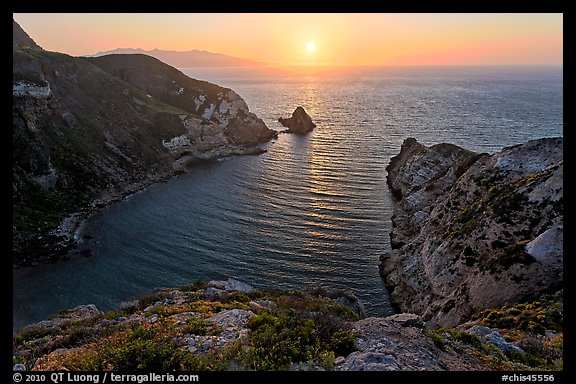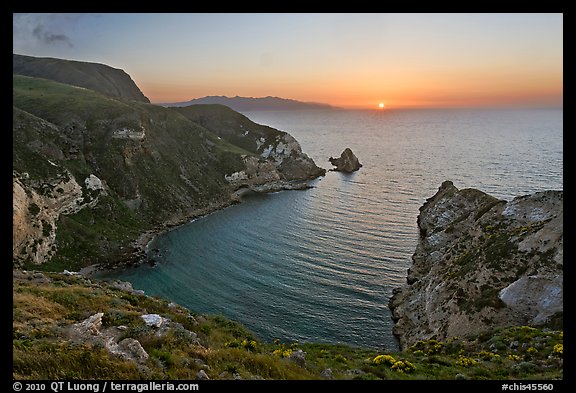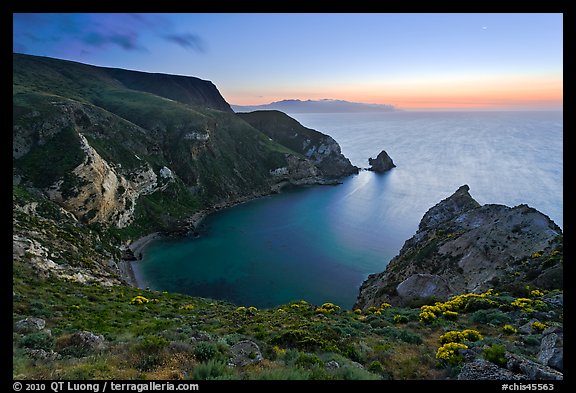New images: three Santa Cruz Island sunsets (polls)
4 Comments
Here are three sunset images from my recent trip to Santa Cruz Island, the largest of the five islands that make up Channel Islands National Park.
They were taken at Potato Harbor Overlook, which is reached through a 5-mile RT hike that is the most rewarding in the Scorpion Ranch area. The fjord-like Potato Harbor has a more dramatic shape than the over coves I have seen so far in Channel Island.
As I was photographing straight into the sun, it was necessary to control the contrast, otherwise the sky would have been blown out or the seascape totally dark. On my 5×7 camera film camera, I had no choice but to use a graduated neutral density filter. However, for those digital images (Canon 1Ds III), I preferred to blend multiple exposures in order to avoid the darkening of the cliff on the left which would have resulted from using the filter.
The three images were taken from slightly different viewpoints, 15 minutes before sunset, at sunset, and 15 minutes after sunset, respectively.
Which image do you prefer ? (click link for poll)
I used three different techniques to blend the exposures. One of the images was blended using directly Photoshop’s HDR function (except for the water, where this created nasty ghosting artifacts). The two other images were done by superimposing (using layers) a bright image over a dark image, and then adjusting locally the transparency of the bright image. For the first, I selected the brightest areas using a luminosity mask, that I then erased. The advantage of luminosity masks is that they produce continuous, gradual selections that don’t result in visible transitions or halos. For the other image, I worked entirely manually, erasing the upper layer by hand with the eraser tool, with the brush set to hardness 0.
Are you able to tell
which one was processed most automatically (Photoshop HDR) ?
which one was processed less automatically (just the eraser) ?





These are all really nice, and regardless of which method was used on each image, they all look good to me (some slight haloing on the left-hand ridgeline of the sunset image, though).
I’ve voted…looking forward to seeing the results!
Hi Tuan,
Easy choice… #1. The light on the water and near the sun makes the entire image work. The other two are softer, but with few clouds in the sky they don’t have any interest above the horizon. Since the cliffs on the left are below the sun,two strong grad filters tilted 10am-4pm with only the top part of the picture in the darkest area of the grad, would not make the cliff darker! I’m not which one was processed how since the images are small on my monitor. There does seem to be a halo around the land on the left side of #1, though it is hard to see it. Still, I’ll go with #1.
Cheers,
Patrick
Oops…. a halo on the right side of#1! No way to edit after you post here!
I guess i can speak french 🙂
Ma favorite est immédiatement la 3 pour plusieurs raisons :
– J’aime toujours ces images aux heures où le soleil vient de passer sous l’horizon.
– La pause semble être la plus longue (ou alors le vent s’est calmé) et la mer est magnifique et l’on voit très bien les nuances du fond.
– Le premier plan me plait plus et de par le cadrage, la baie semble plus arrondie que sur les 2 précédentes.
Quant aux traitements j’ai un peu du mal à faire la part des choses car les images sont petites et comme je n’utilise pas photoshop je ne connais pas bien le rendu de sa fonction HDR.
Sinon sur la troisième j’aimerai bien avoir une idée de la douceur de la transition entre le bleu et le jaune clair.
Voilà, le temps d’écrire tout ça, de regarder une dernière fois les images et je confirme que ma préférée est bien la 3 🙂